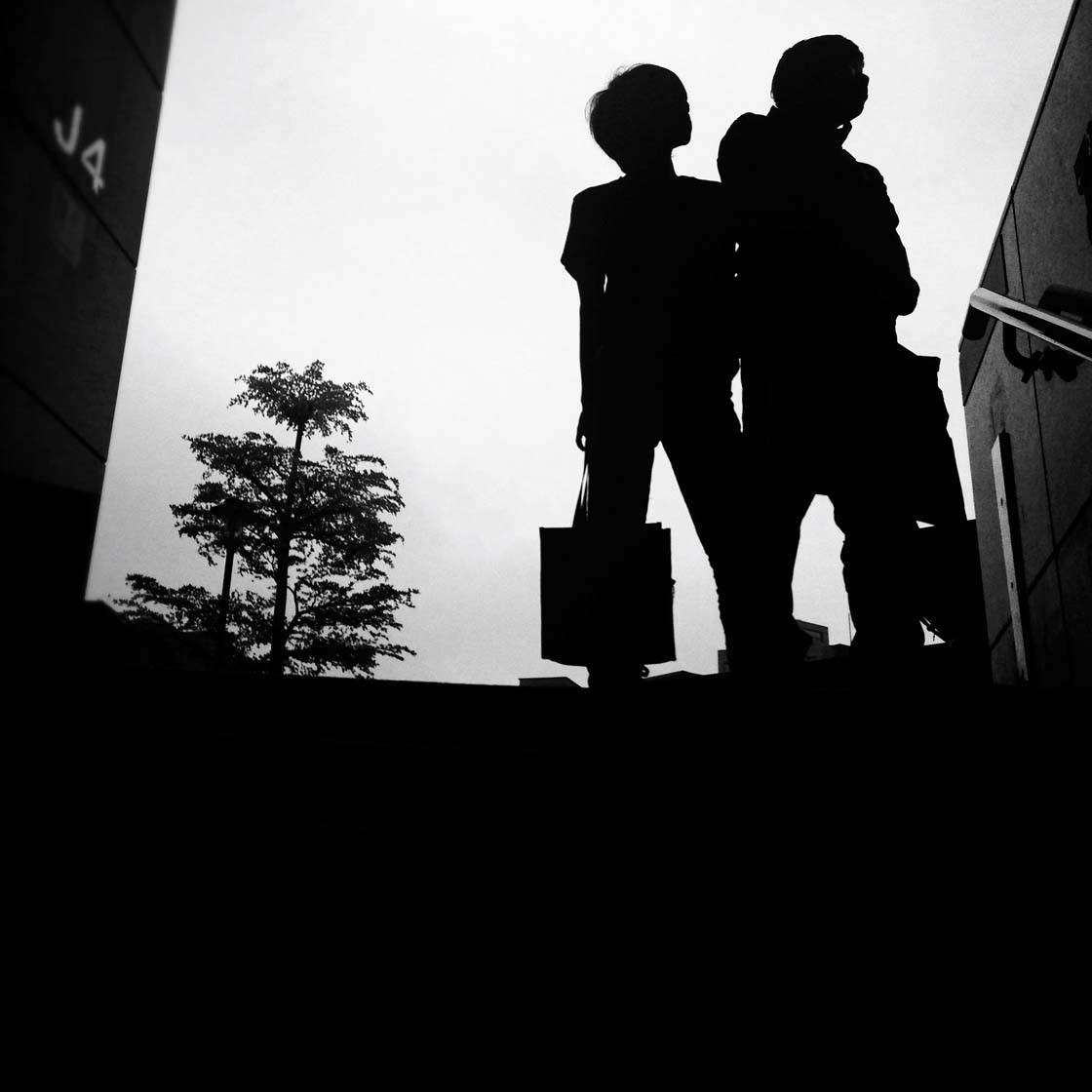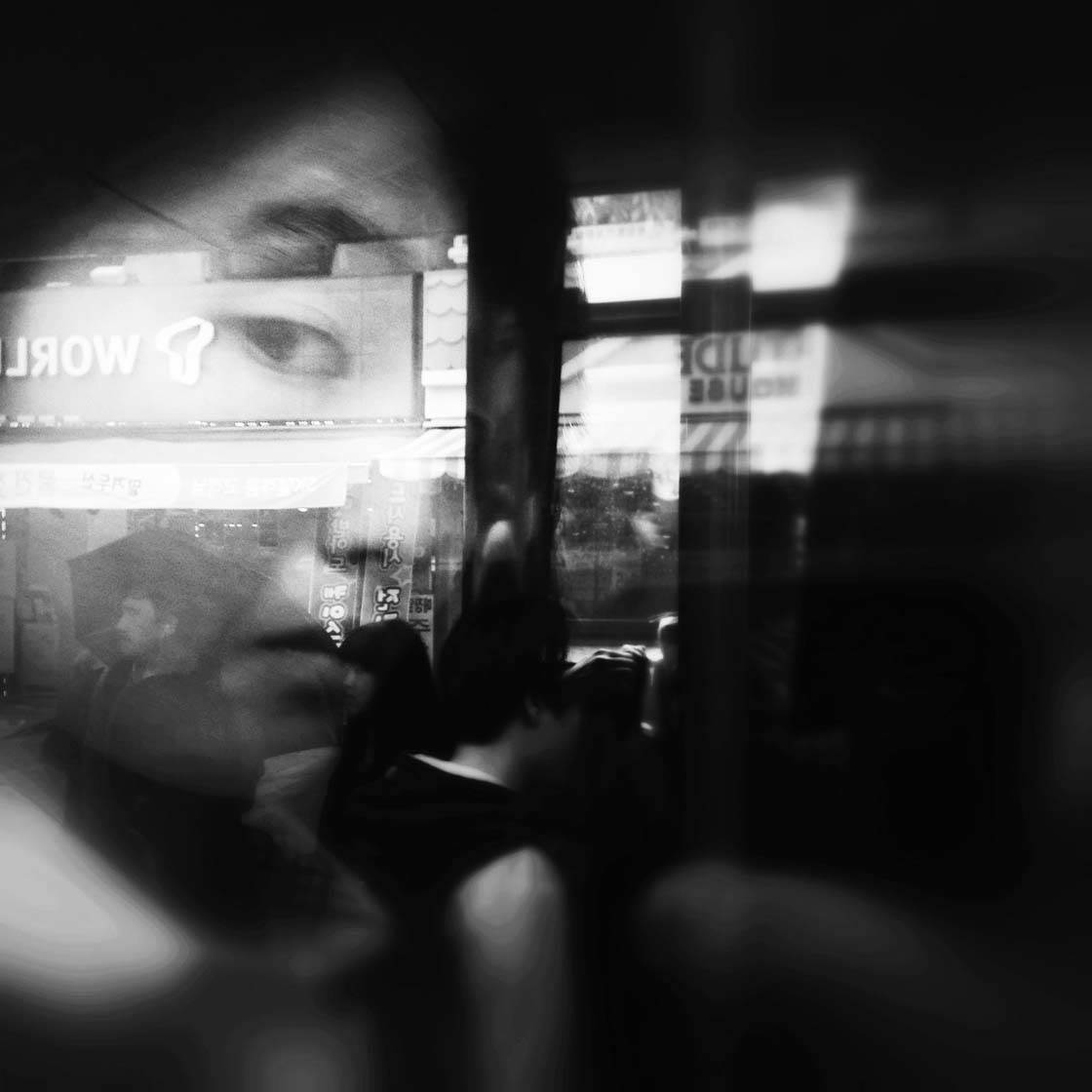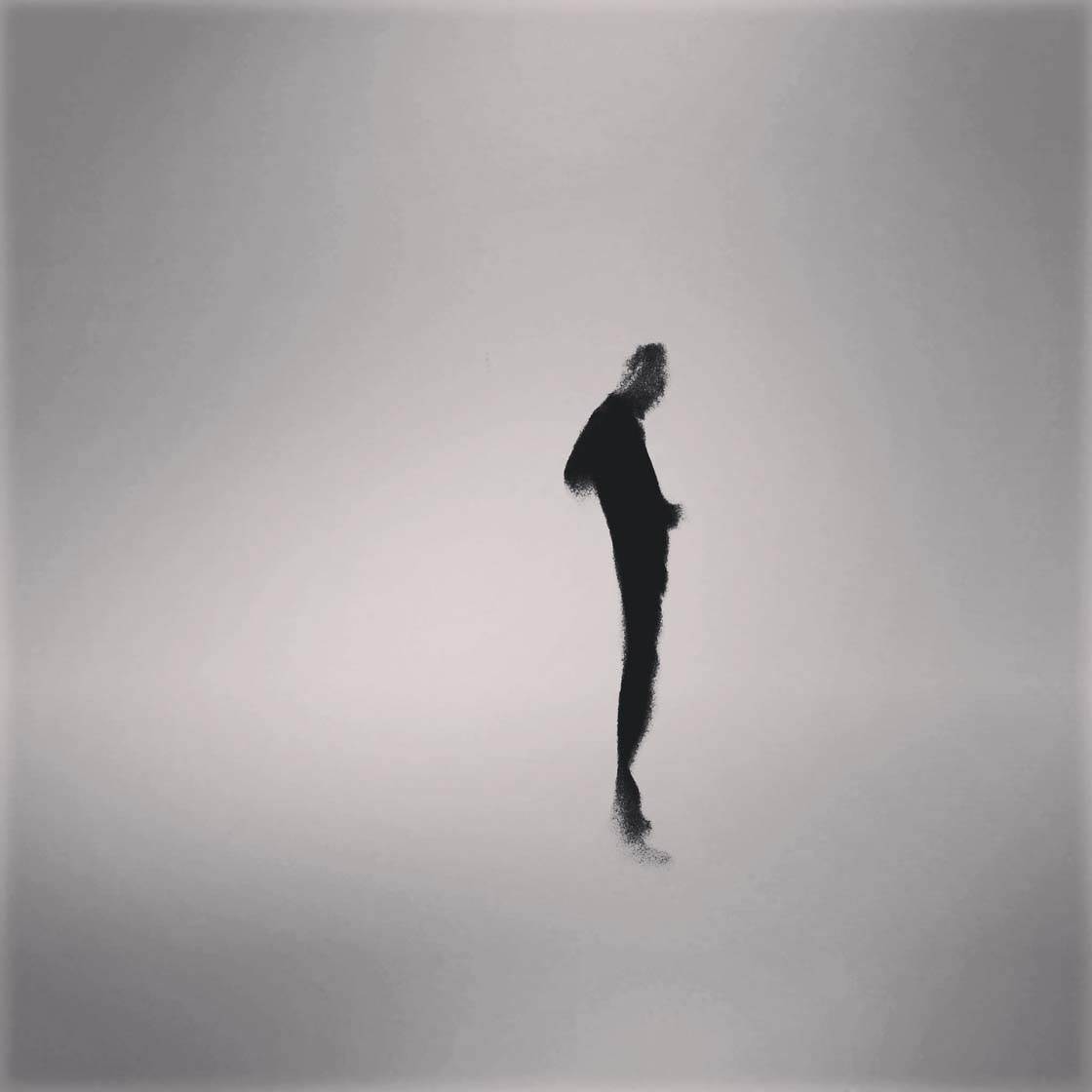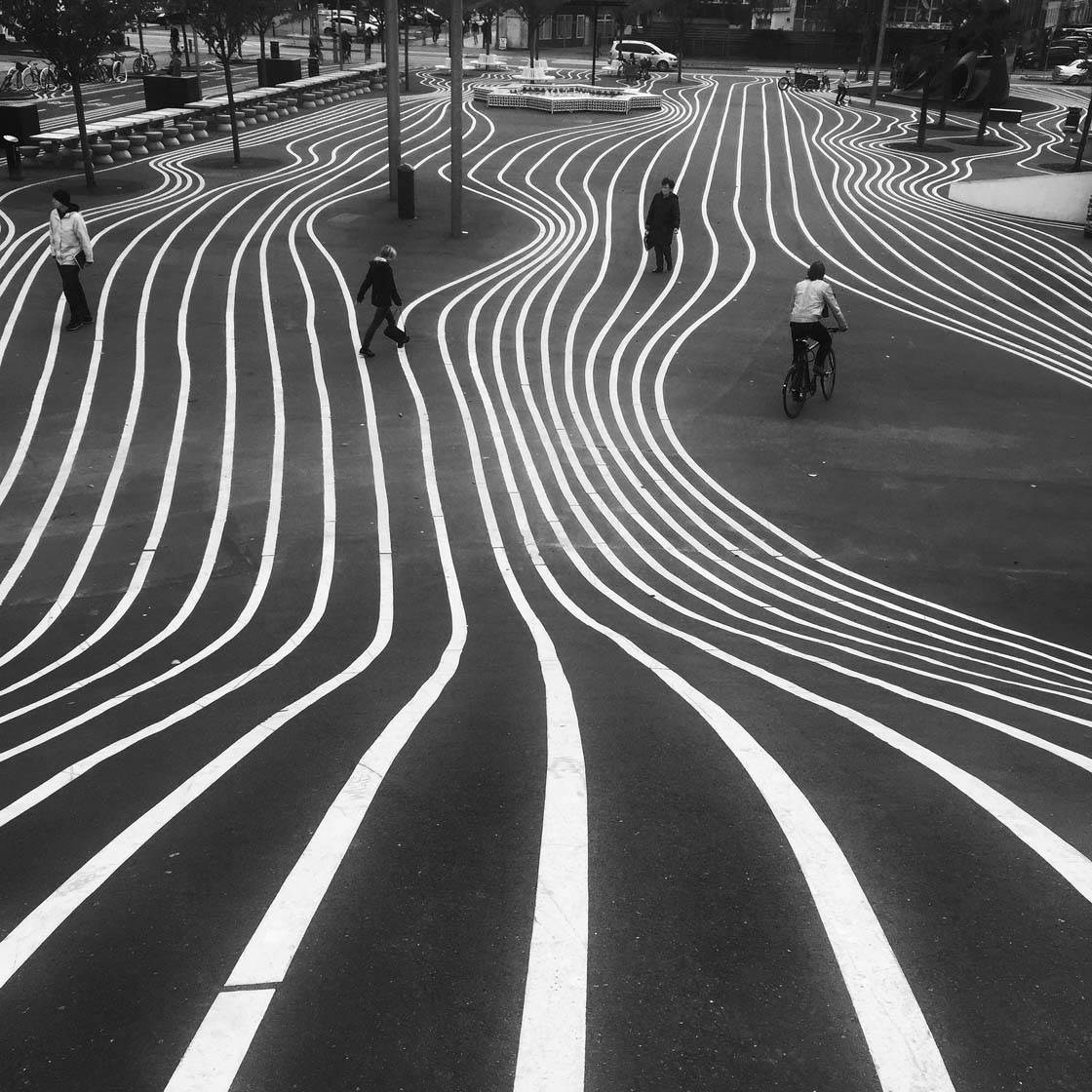I’m really excited to share this interview with Brendan Ó Sé, an award winning mobile photographer who currently has one of his iPhone photos appearing on billboards around the world in Apple’s campaign to promote the iPhone 6. Brendan mainly shoots street photography, often using techniques such as intentional camera movement, motion blur and reflections to create intriguing abstract images. In this interview you’ll learn more about Brendan and how he takes such wonderfully creative photos with his iPhone.

Tell us a little bit about yourself.
Firstly, thanks for this opportunity Kate. To give you some background, I am a university teacher/teacher trainer from Cork in Ireland, working at my local university.

I’m married to a very patient and loving wife, and we have two small children. Sumi-Anna is 7 years old and James is 4.
How did your iPhone photography journey begin?
My main hobby is photography. I had been messing around with photography on and off for years before getting into it seriously around 2009.
The first time I realized the potential of the iPhone as a camera was on a family trip to Asia in 2012. It was a liberating experience being able to get up close to capture street moments.

Being able to process the images and share them with friends and family immediately was incredible. I took hundreds of images on that trip and began to post regularly on Instagram.
When I returned to Ireland and back to posting on Flickr, I discovered there were many mobile photography groups. The quality and diversity of the images inspired me to experiment and explore more.

I’m a believer in the old saying that the best camera you have is the one you have with you, and the iPhone is always with me; always ready. In the past three years, I’ve taken many more photos with the iPhone than my DSLR.
I believe that while the genre at the moment is still called mobile photography, the mobile part will, in time, be dropped. After all, when has a camera not been mobile?
What inspires you to take photos with the iPhone?
My maxim about photography is: “Trying to see what can be seen and how to see it.” I find that I’m constantly framing scenes, always looking for opportunities to get that shot.
Having the iPhone with me is a great advantage. It’s the perfect size. It fits in my pocket and sits in my hand so comfortably allowing me to shoot. I never leave the house without it, so it’s always with me. The days of missing that shot because of not having a camera are gone.

A few years back, I set up a separate Flickr account for my iPhone work. Having this encourages me to build up a body of work just with the iPhone. Any time I post to Flickr, it’s always two images – one with a DSLR and one with the iPhone. Following the iPhone work of my friends also keeps me motivated.
You mainly shoot street photos with your iPhone. What draws you to this genre of photography?
I love people-watching and observing their interactions. If you want to learn about a culture or a people, the best way to do so is to observe them. In public, people can be guarded, but they do reveal. With street photography it’s those moments you chase.

You look for a connection and very often this is a connection to your own condition. It’s a crazy coincidence that we’re all here at this present moment sharing the world and trying to make sense of it all.
I look for stories I can relate to and possibly understand. In many ways, I’m looking for myself on the street – looking for identifiable feelings and connections. Street photography can be empathetic and compassionate. It helps me to learn more about life and more about myself.
You also like to create wonderful abstract images. How do you go about creating these mysterious and intriguing photos with the iPhone?
Intentional camera movement. I point the phone down, and then with an upward swipe I release the shutter to produce the blurred effect.

You can see this technique in action in this short video that was made by the well-know Irish journalist Glen Mulcahy.
Another technique is to keep my finger over the lens and then to release it quickly as I snap. This creates an overall blurred effect on the image.
How important is it to include human subjects in your street photos?
I would say it’s very important. Initially, it could be a backdrop or light that would draw me to a location, but without the human element there’s a location but very often not a story.

Being from a small city, there aren’t that many streets. I’ve found good locations in Cork and often waited for ages for someone to pass and fill the frame.
One of the main challenges with street photography is photographing people you don’t know. How do you deal with this?
I brave it out. With time I’ve become more instinctive as to whose photo I should try to get or not. In my hometown I’m much more reluctant, even afraid. Hoisting a camera and snapping someone can be interpreted as confrontational.
It’s much easier when I’m traveling. Being a tourist gives you a license to photograph and for some reason I always feel safer and braver when I’m traveling.

I avoid shooting homeless people, children or people in evident distress. I prefer people not to be aware of being photographed. I prefer not to intervene so as to capture a candid moment. If it happens that after the shot they notice me, I smile and nod thanks and usually move on.
If I’m met with a welcoming smile, I might offer to show the person or people the image. On occasion, some people have insisted that I delete the image, and I always agree. However, this has only happened a couple of times.
A lot of your photos are taken at night or in low light, which many people find challenging with the iPhone. What tips do you have for taking great iPhone photos at night?
I had not realized that, to be honest. I always use ambient light, and am not overly concerned with the subjects being crisply in focus. They don’t need to be perfectly sharp to convey a feeling, mood or story. I never use flash. As for tips for using the iPhone at night, just get out there and enjoy yourself.

Congratulations on receiving several Honorable Mentions in the prestigious Mobile Photography Awards! Could you tell us a bit about the recognition you’ve received, and what effect this has had on your iPhone photography?
Thanks! I was really pleased to get six Honorable Mentions across four different categories. While I was initially disappointed not to win a category, I came to realize that it was quite an achievement to get so many Honorable Mentions.
To consider what effect it has on my mobile photography, I can say that there is validation in the recognition and it’s exciting to see my images featured with the great work being done in the mobile photography community.

Of course, it’s all about learning. Reviewing my images now, I do so with a critical eye looking for ways to improve. Doing well in the competition drives me on to try to improve. And as the old saying goes “It’s all about the next photograph.”
Let’s talk about photo apps. Are there any apps that you use for taking photos besides the native camera app?
I’m not a big fan of “apptography.” Over the years, I’ve downloaded a lot of photo apps, but have deleted them very soon after. I tend to keep things simple. An excellent app is Manual. As the name suggests, it allows you to manually adjust the settings in the camera.

Another app that I really love is 1-Hour Photo. This is a fun app that produces really good results. It’s a throwback to the analog days when you shot and had to wait until the film was developed to see your photos.
With this app, you shoot and one hour later you get a notification telling you that your shot has been developed. You can only shoot in black and white with 1-Hour Photo.
What are your favorite apps for post-processing?
The one-stop-shop that is Snapseed, and that alone. I’m a huge fan of Snapseed and nearly all my photos are processed with this app (check out our in-depth Snapseed tutorial).
I usually use Snapseed for conversion to black and white, cropping and some work on contrast. Occasionally, I might freak out and grunge things up. Why not?

Do you use any iPhone photography accessories?
Only a good case. I find accessories, like so many apps, to be gimmicky and limited. I did try an attachable lens once and didn’t like it at all. I’ve heard that the Olloclip lenses are good, but it’s not for me. I like the limitations of the iPhone camera. It makes me try harder.

Can you briefly explain the story and editing behind your three favorite iPhone photos?
It’s hard to choose three favorites, but if I have to these would the three.

The first image I’ve chosen is probably the simplest in form that I made recently. Four feet and four shoes, but three people, cropped just below the knee. One black shoe of a man extending towards a white high-heel of a woman, while on the other side another black shoe stays hesitant.
All the while I sat opposite, about two feet across from them. The woman made eye contact with me as I took the iPhone out. I held it on my lap, lowered it to the level of my knees and composed the shot and got it.
Looking up, I saw she was still looking at me. I nodded. She lowered her head and pulled her feet in towards her seat. The others’ feet shuffled. At the next stop she disembarked.

The second image I’ve chosen as a favorite of mine is this one taken in Copenhagen last year. It’s such a cool location. I’d seen it in the photographs of Thomas Toft, a friend (and a wonderful photographer) on Flickr. He kindly agreed to bring me here when I was in Copenhagen. I converted the shot to black and white in Snapseed.
I was absolutely thrilled when I was learned that the image would be used as part of Apple’s campaign promoting the iPhone 6. I never in my wildest dreams could have imagined that an image of mine would be on billboards all over the world – it’s so cool. I’m so grateful to Thomas for bringing me to this location.

As I said, choosing three of my favorite images is really hard, but if I had to, then the third one would be an image which has a strong personal connection. A very good friend of mine passed away a few weeks back and this image is in dedication to him.
Do you use any other cameras, and if so, when do you prefer to use the iPhone?
I have two Nikon DSLRs and a recently-purchased Fuji X100T. I love the iPhone for family snaps and videos – it’s so handy.

As for shooting on the street, if I find a good location or scene, I tend to use both the iPhone and a regular camera. For candid street shots, when you want to get in close and do so without being noticed, nothing matches the iPhone. It’s a perfect fit for my hand and so easy to use discreetly.
Do you have a favorite location for taking iPhone photos?
Tokyo and Seoul. Coming from a small city, there’s something so exciting about being in huge world cities. These two cities are perfect for street photography – so many streets and so many people! You can’t help but feel electrified with life in these places.

They may be monstrous cities with so much activity, but the best thing is that they’re so safe and in the times I’ve been there I’ve found the people to be super-friendly. I can’t wait to get back.
What tips do you have for beginner iPhone photographers who want to start taking more creative photos with the iPhone?
Set up a Flickr account and join groups like Mobiography, The App Whisperer and iPhoneography Central. Submit photos and look at those in the group pools. Check the weekly showcases that these sites do. Very often they offer backgrounds to how the shots were created.

Visit their sites for tutorials on how to create images. And of course, don’t forget iPhone Photography School. This is a great starting point for anyone wanting to learn and improve.
But the advice I would give more than any other is to have fun. Photography is a wonderful hobby, and hobbies are about enjoyment. Make photographs of things you love. Make memories.
Which iPhone photographers do you admire the most?
Michael Kistler (@mdkistler) is doing some of the best iPhone work out there at the moment. His work consistently hits the heights. (Check out our interview with Michael).
Shel Serkin (@shelserkin) won the Grand Prize in the Mobile Photography Awards and with good reason – he is just a wonderful storyteller and photographer.

Others I really admire on Flickr are Mark T. Simmons and Janine Graf. On Instagram, Lorcan Finnegan (@lorcanfinnegan), Mimo Khair (@mimokhair), Ade Santora (@adesantora), Laurence Bouchard (@laurence__bouchard), Albion Harrison-Naish (@albionsamson), Lee Thatcher (@leethatch) and Lee Atwell (@lee_atwell).
The list could go on and on. There’s some great photography being created on iPhones.
Where can we see your iPhone photography?
I post all my iPhone photography to this Flickr account. And I also post on my blog: photographicpunctuation.com



Very nice and simple approach to photography. Thanks for making the interview.
Thank you Cachorro. I am glad you liked it.
Thank you Brendan for sharing your knowledge and wonderful iPhone photography with us.
Thanks Kate. It was my pleasure.
Fab interview Brendan, well done.
Thanks Fotoco